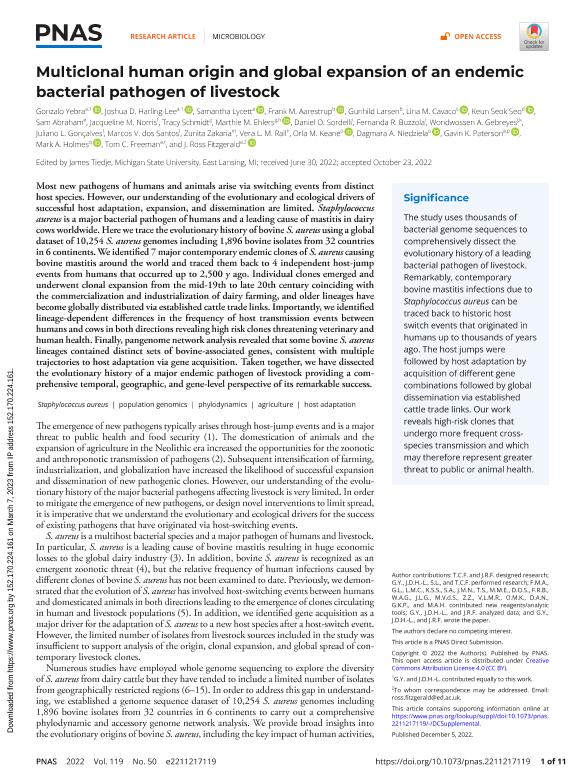Artículo
Multiclonal human origin and global expansion of an endemic bacterial pathogen of livestock
Yebra, Gonzalo; Harling Lee, Joshua D.; Lycett, Samantha; Aarestrup, Frank M.; Larsen, Gunhild; Cavaco, Lina M.; Seo, Keun Seok; Abraham, Sam; Norris, Jacqueline M.; Schmidt, Tracy; Ehlers, Marthie M.; Sordelli, Daniel Oscar ; Buzzola, Fernanda Roxana
; Buzzola, Fernanda Roxana ; Gebreyes, Wondwossen A.; Gonçalves, Juliano L.; dos Santos, Marcos V.; Zakaria, Zunita; Rall, Vera L.M.; Keane, Orla M.; Niedziela, Dagmara A.; Paterson, Gavin K.; Holmes, Mark A.; Freeman, Tom C.; Fitzgerald, J. Ross
; Gebreyes, Wondwossen A.; Gonçalves, Juliano L.; dos Santos, Marcos V.; Zakaria, Zunita; Rall, Vera L.M.; Keane, Orla M.; Niedziela, Dagmara A.; Paterson, Gavin K.; Holmes, Mark A.; Freeman, Tom C.; Fitzgerald, J. Ross
 ; Buzzola, Fernanda Roxana
; Buzzola, Fernanda Roxana ; Gebreyes, Wondwossen A.; Gonçalves, Juliano L.; dos Santos, Marcos V.; Zakaria, Zunita; Rall, Vera L.M.; Keane, Orla M.; Niedziela, Dagmara A.; Paterson, Gavin K.; Holmes, Mark A.; Freeman, Tom C.; Fitzgerald, J. Ross
; Gebreyes, Wondwossen A.; Gonçalves, Juliano L.; dos Santos, Marcos V.; Zakaria, Zunita; Rall, Vera L.M.; Keane, Orla M.; Niedziela, Dagmara A.; Paterson, Gavin K.; Holmes, Mark A.; Freeman, Tom C.; Fitzgerald, J. Ross
Fecha de publicación:
12/2022
Editorial:
National Academy of Sciences
Revista:
Proceedings of the National Academy of Sciences of The United States of America
ISSN:
0027-8424
Idioma:
Inglés
Tipo de recurso:
Artículo publicado
Clasificación temática:
Resumen
Most new pathogens of humans and animals arise via switching events from distinct host species. However, our understanding of the evolutionary and ecological drivers of successful host adaptation, expansion, and dissemination are limited. Staphylococcus aureus is a major bacterial pathogen of humans and a leading cause of mastitis in dairy cows worldwide. Here we trace the evolutionary history of bovine S. aureus using a global dataset of 10,254 S. aureus genomes including 1,896 bovine isolates from 32 countries in 6 continents. We identified 7 major contemporary endemic clones of S. aureus causing bovine mastitis around the world and traced them back to 4 independent host-jump events from humans that occurred up to 2,500 y ago. Individual clones emerged and underwent clonal expansion from the mid-19th to late 20th century coinciding with the commercialization and industrialization of dairy farming, and older lineages have become globally distributed via established cattle trade links. Importantly, we identified lineage-dependent differences in the frequency of host transmission events between humans and cows in both directions revealing high risk clones threatening veterinary and human health. Finally, pangenome network analysis revealed that some bovine S. aureus lineages contained distinct sets of bovine-associated genes, consistent with multiple trajectories to host adaptation via gene acquisition. Taken together, we have dissected the evolutionary history of a major endemic pathogen of livestock providing a comprehensive temporal, geographic, and gene-level perspective of its remarkable success.
Archivos asociados
Licencia
Identificadores
Colecciones
Articulos(IMPAM)
Articulos de INSTITUTO DE INVESTIGACIONES EN MICROBIOLOGIA Y PARASITOLOGIA MEDICA
Articulos de INSTITUTO DE INVESTIGACIONES EN MICROBIOLOGIA Y PARASITOLOGIA MEDICA
Citación
Yebra, Gonzalo; Harling Lee, Joshua D.; Lycett, Samantha; Aarestrup, Frank M.; Larsen, Gunhild; et al.; Multiclonal human origin and global expansion of an endemic bacterial pathogen of livestock; National Academy of Sciences; Proceedings of the National Academy of Sciences of The United States of America; 119; 50; 12-2022; 1-11
Compartir
Altmétricas



